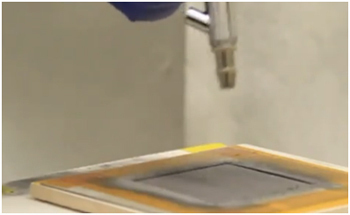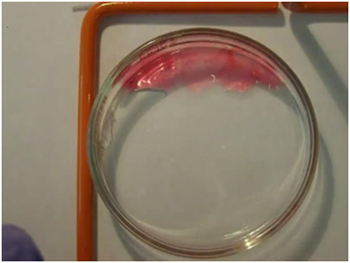6 Substances That Wipe Their Ass With the Laws of Physics

Physics is a bastard that can't be trusted. Just walk off a cliff and see how willing it is to turn on your "I love science!" ass with the slightest provocation. Luckily, humanity has its ways of sticking it to the laws of matter and motion. We pointed it out before, but it's worth reiterating that modern geniuses are more than capable of mooning physics with the twin butt-cheeks of innovation and technology.
Graphene Can Do Almost Anything

Visible to the human eye in a layer that's only one atom thick, able to bend into shapes that would make your mom blush (no small feat, the strumpet), and pound-for-pound quite probably the strongest material in the world -- graphene is undoubtedly a bad motherfucker.
In fact, it shows incredible properties in almost every field of strength and conductance. It transports electrons 10 times faster than silicon, and may soon be replacing it as the go-to material for transistors and computer parts. If that's not impressive enough for you, how about the fact that graphene is technically a plastic, so it should have no business conducting electricity -- yet here it goes like it ain't no thing.

It's the plastic equivalent of that cool guy at the bar who keeps calling people "baby girl."
We're talking about "charging iPhones within five seconds" conductivity here. Imagine a world with electric cars that recharge as quickly as filling your tank with gas, or paper-thin foldable plastic phones that recharge the instant you set them down -- that's exactly what graphene offers.

Great. Even douchier phone snobs. Thanks a lot, you stupid scientific miracle.
And then there's the slight matter of its strength. Mix graphene with metals, and it increases their resilience 500-fold. But hell, you've been around the block. You've seen a few fancy new materials in your day -- lithium-ion batteries? Carbotanium? -- we'll forgive you if you stifle a yawn at mere strength and conductivity claims.
So here, meet graphene aerogel, one of the lightest materials in the world -- seen resting on a delicate plant without so much as bending the spines.

That's right, the future will finally give us a phone that's safe to accidentally drop on our balls.
So yeah, our friend Gary told us he heard that graphene is currently taking applications for "its bitch," if you wanna go ahead and submit a resume.
LiquiGlide Makes a Fool Out of Friction

LiquiGlide is an insane, super slippery coating that prevents literally anything from sticking to it. Here's a LiquiGlide-coated ketchup bottle:

Good things come to those who don't waste their entire day trying to eat fries.
That was Round 1. Here's Round 2, in which LiquiGlide takes on a new challenger -- mayonnaise:

We wouldn't have thought mayonnaise could move any grosser, but there it goes.
Hahaha, you have no power here, condiments.
The obvious worry (since it's being demonstrated on food containers) is whether or not the stuff is safe for consumption -- after all, even non-stick mayo isn't worth it if it gives you a night of Olestra-caliber non-stick intestines. Fear not: LiquiGlide is made of completely edible, flavorless materials. Feel free to coat your dishes with the stuff, and never again worry about washing up!
Of course, you will have to worry about the slightest arm motion sending your frictionless mac-and-cheese Frisbeeing off your plate and across the living room -- but hey, just LiquiGlide the walls and you're all set. And the floors. And the couch. LiquiGlide everything.
LiquiGlide.
Everything.

EVERYTHING.
Who would have thought the world wound end this way? Not with a bang, but the soft shuck of everything on Earth softly sliding away into space.
Spray-on Batteries Turn Anything Into a Power Source

One of the greatest daily struggles of modern life is the Scourge of the Empty Battery. If you've ever been three quarters of the way to "there" when your tablet died and all of your PornHub tabs cried out in terror and were suddenly silenced, science has got your back. Researchers at Rice University are not the first to tackle the battery issue, but their solution is by far the most elegant: They're planning to wave the conventional battery goodbye and replace it with a battery compound that can be spray-painted on any surface.

"Yes, batteries. Now who feels stupid, officer?"
Here's how it works: A conventional lithium-ion battery is made of the anode, cathode, and electrolyte. These ingredients are assembled to form the physical battery that we all know and are constantly disappointed in, like the parents of a Liberal Arts major moving back home after graduation. The scientists turned it into spray form by simply liquefying each of the components, presumably while stroking a white cat and muttering about how they've failed for the last time.
The technique seems to work on pretty much any material, from steel to wood to ... novelty beer steins?

Time to party like a properly certified electrician.
Hey, nobody said you had to science sober, did they? All you have to do is spray the battery over a surface ...

... and it can start powering your device instantly.

"At last, the world will know my preferred side dish."
Researchers have found that an object turned into a power source with the battery-spray treatment is currently able to keep a set of 40 LEDs working for six hours, and it's completely rechargeable. However, as enticing as powering your laptop with a novelty drinking accessory may seem, it's worth remembering that the technology is not exactly at commercial stage yet. Constructing a functional spray-on battery requires multiple layers of different "paints," and attaching one to your gadget of choice requires a fair bit of creative wiring. But it's all worth it when you power on your Xbox using only that Amish man's beard and note the exact second he sees the devil.
Terminator Polymer Heals Itself

The self-healing substances that science has managed to develop in the past have been relatively shoddy affairs, fixing small cracks with resin in a manner that is closer to the way your body slowly heals small wounds than it is to full-on T-1000 "this should not be" awesomeness. What we're about to show you is an altogether different beast. Meet the world's first truly self-healing polymer:
If you didn't watch the video, here's a play-by-play: First, they cut a chunk of the stuff in half.

Then, they put the pieces back together and go get some lunch.

And ... holy shit, this should not be!

Finally, a terrified disbeliever grabs the restored piece and stretches it, trying to find evidence of the wound, but discovers nothing.

Silly Putty has come a long way.
Then the rest of the video is pretty much just the frightened scientists crying, "What have we done?! Truly, we are all sons of bitches!"

"This is worse than the time we invented that device that shows who the real monsters are!"
The polymer can currently heal from basically any damage within a couple of hours and with 97% efficiency, thus giving Wolverine's healing factor a run for its money. It's not just fancy scientist stuff, either -- the material is inexpensive, fairly simple to make, and quite possibly will be available soon for everyone.
Incidentally, the T-1000 comparisons we've been so liberally using are not just throwaway jokes: Researchers have actually nicknamed the material "Terminator Polymer" as homage to the famous self-healing liquid-metal killing machine. They named it for a killing machine. We suppose some folks are too busy majoring in Blasphemous Chemistry to take a quick minor in Situational Irony.
Hey, speaking of T-1000 ...
Shapeshifting Metamaterial Can Remember

Researchers at Cornell University have recently stumbled upon a type of shapeshifting DNA metamaterial -- a synthetic hydrogel that can remember its original shape and return to it. We're not going to make another joke about the T-1000 here ... because, again, it's the Cornell guys themselves who are happily comparing their strange new technologies to an allegory about technology being the downfall of mankind.
In the beginning, it's just liquid on a plate.

Hey, let's add some water and see what happens:

Wait, is it moving on its own?

It's almost as if those red blobs are forming some sort of ... holy crap it's trying to communicate!

It's trying to spell "do not attempt resistance."
Those letters spelling out "DNA" were actually the material's original form, and the addition of water acted as a signal for it to resume that form. It can also pull the same trick in 3D:

It changes to "W-O-O" if you replace the water with grain alcohol.
If it just sounds like a fancy version of those little dinosaur sponges you toss in water ... well, it's ... probably not? In fact, what's going on here is so strange that even the scientists themselves aren't able to explain exactly how it works.

Clearly it's the height of microscopic tumbleweed technology.
But hey, don't let the academics in charge saying "This material we compare to a famous murderous technological monster is far beyond our understanding, and we have absolutely no control over it" worry you.
We mean, it probably should worry you -- but what the hell are you gonna do about it? No point fretting over a fate that has clearly already been decided for you.
Starlite Is Immune to Heat (and Nuclear Blasts)

Starlite may sound like a particularly unfortunate member of the 1990s X-Men, but it's actually pretty much the coolest substance in the world. We mean that literally: The material can withstand extremely high temperatures and remain unaffected.
We here at Cracked are nothing if not sober and responsible with our language.

Well, the language thing is true at least.
Starlite is not the product of a professional research team, or even a radioactive accident at the roller disco that produced the funkiest superhero since Frozone. The material was invented by a talented amateur chemist called Maurice Ward, who somehow managed to cook it up in his kitchen two decades ago. It has since gone on to become one of the best-kept secrets in the science world.
Take a look:
That's a perfectly ordinary egg, just chilling (again, please do not assume we're resorting to something as base as slang here) while being heated with an oxy-acetylene torch.

The man then picks up the super-heated egg like it's no big deal, even though its surface has just been blasted with a diamond-melting 6,000 degrees fahrenheit.

Now that's a man with some huevos.
Then he breaks open the egg to show us that it's not even slightly cooked.

It's the watershed technology that ruined breakfast.
Here's what happens to normal paper under the acetylene torch:

And here's how Starlite-coated paper fares in comparison:

Initially, scientists refused to believe the near-magic properties of Starlite, which wasn't surprising considering its hokey name and lofty birthplace of "some dude's kitchen." Some believe it's a hoax, others, a conspiracy. However, test after test after test by all sorts of independent experts showed that it could do everything it promised, and more: Military researchers obtained a sample and subjected it to temperatures close to 10,000 degrees, and even a nuclear flash equivalent to 75 Hiroshimas.
Boeing and NASA both expressed interest, seeing as the material could potentially revolutionize the world -- heat-resistant paneling, nuke-proof condoms, lava wakeboards! -- and Ward was in talks to sell to them, but the deals fell through when Ward flat-out declined to give the recipe for Starlite away. He would license production, as much as they wanted, but the recipe stayed his alone. He even refused to patent the compound, as it would have required him to reveal its secrets. Sadly, Ward died in 2011 without a production deal in place, and Starlite is nowhere to be seen. Still, there is hope: Ward's family is said to be in possession of the recipe, so unless the government has declared it Top Secret -- which may have actually happened -- you might still get the chance to slip your willy into a volcano someday.
Until then, you must take solace in your dreams alone.
Curious about substances that laugh in the face of physics? Read about Gallium, the metal that melts in your damn hand. And we've got more: Aerogel looks like clear jello and is totally immune to fire. If you're still not sated, click here for some unbelievable man-made materials.